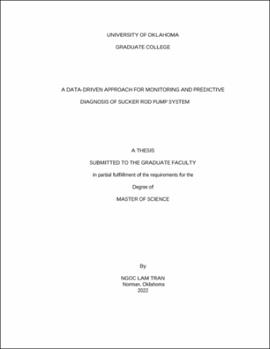| dc.description.abstract | Given its long operational history, a sucker-rod pump (SRP) has been widely utilized as a lifting solution to bring reservoir fluids to the surface with low cost and high efficiency. However, debugging the rod pump issues requires on-site activities that could cost time and money for operators. With the vast dataset collected from years of operation, numerous companies are looking to turn these engineering processes into automated systems in the oilfield network, despite the complexity of data and lack of knowledge. The integral approach is to develop real-time diagnostics for downhole conditions. The emerging artificial intelligence and big-data analytics have provided relatively precise downhole condition forecasting based on available data, enabling better decision-making. This thesis focuses on collecting representative data and utilizing machine learning techniques to predict operational anomalies of sucker-rod pumps.
An experimental design at the University of Oklahoma, referred to as Interactive Digital Sucker Rod Pumping Unit (IDSRP), was used to facilitate a data-driven solution and monitor SRP performance and diagnostics. The physical framework includes a 50-ft transparent casing and tubing with a downhole rod pump at the bottom. A linear actuator provides the rod string’s reciprocal movement and simulates different surface units and operating scenarios. This facility uses proper instrumentation and a data acquisition system for signal sensor readings. A workflow is developed to translate surface dynamometer cards to downhole ones and train predictive models in time-driven pressure and rate data. Though primarily focusing on the normal pump operation, the test matrix varies in stroke length, pump speed, and rod movement shape.
The tests validate the model to classify and detect various operational conditions in sucker-rod pumps. The model dynamically categorizes the pumps into key states of ideal condition and over-pumping with a regression fit of accuracy higher than 0.7 and overall classification accuracy of 92%. Moreover, the real-time model anticipates an event in which the pump experiences a slight pumping-off that could potentially deteriorate the rod. The results also help understand key features that drive sucker rod pump performance prediction and help detect anomalous pump behavior. The machine learning algorithms, developed by the physics-based inputs, generate predictive models, thus classifying operational conditions or failures of the pump. The diagnosis for the pump’s anomalies is also predicted by a real time analysis. The visualization enables to recognize the patterns and abnormal phases early. The explainable machine learning (i.e. Shapley additive explanation) helps decoding the predictive models with feature importance, local and global sensitivities in categorizing SRP conditions.
The developed unit has the capability of working with different well conditions, combining with real-time training and applying models, to initiate early warnings. The developed processes and workflows have the potential of becoming a generic optimizing and monitoring model for rod pumps. The novelty of this setup consists not only in its mechatronic design but also in through monitoring of the pump operations. | en_US |
